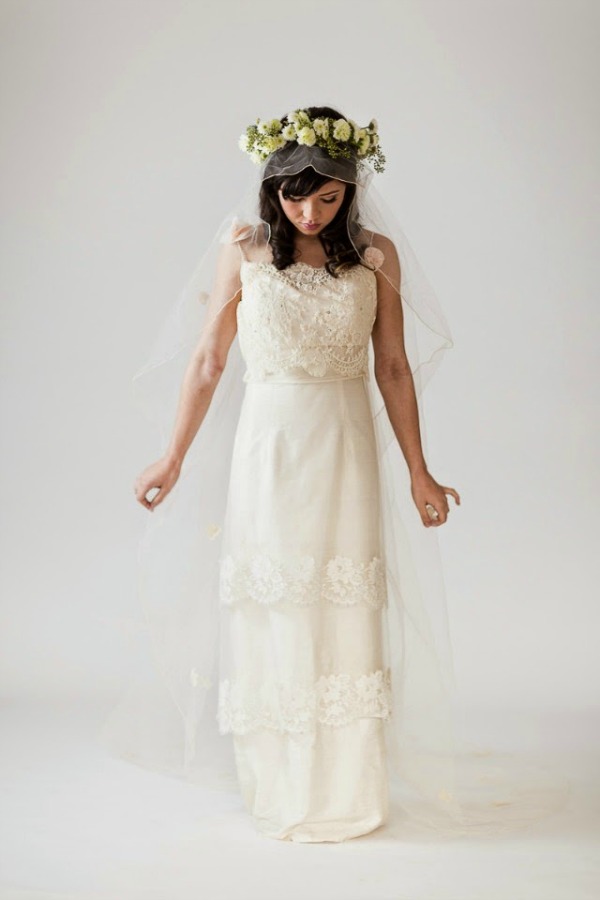SKIRT CHIC
I like to think of the
skirt component as the one in which the most critical movement takes place. The
skirt goes into motion when you put one foot in front of the other and make
your way down the aisle or dance with your groom. And because the skirt is an
action piece, it has a certain ‘living quality’ once you start moving around in
it. Added embellishments like beads and crystals reflect light a different way
every step you take; back slits reveal sexy legs and bustling can transform a
gown one moment from elegance, the next to poetry and romanticism. Consider
once you start really moving around, your skirt, your dress as a whole is
constantly changing with you in it.
Since most gown
silhouettes are based on the skirt proportion of a sheath, ball gown or A-line,
let’s look at a few details within those categories. Skirt details vary and are
filled with special treatments like pleats, overlays and drapes. For instance,
ruffles are a design detail that can add length; deep inverted pleats can add
fullness without bulk to the waist or hips. Zeroing in on which of these
treatments you want is going to be one of your most important decisions.
Draped or bustled-Can be applied to sheaths, A-lines or ball
gowns. A drape is a wrap of fabric pleated or gathered to the side or back
seams of the skirt adding fullness. They can be integrated into the original
pattern or added on in a contrasting fabric. Imagine a 1930s evening gown in a
lightweight crepe, asymmetrically draped front to back. In heavier fabrics like
faille and peau, swathes of draping lend a more sculpted, architectural look to
the gown giving it that Goddess on a Pedestal quality.
Flounce-A ruffle or pleating of any width around the
bottom of the skirt. Seen nowadays mostly as a bit of flounce peaking out of a
skirt overlay.
Tiers-Can be one or up to even ten layers of tiering
in a range of lengths and fabrics. Think of a Spanish dancer.
Graduated Hemline(s)-Again think Spanish Dancer. Hem tapers from a
high to low point. Can be applied as one or more skirts.
Trumpet-Form of princess line with two vertical seams
up front and back with godets (triangular pieces sewn into the seams) adding
fullness around the knees.
Overskirt-Most are detachable and worn over a sheath or
A-line. Could be considered a detachable train if it’s elongated in back.
Overlay-Like the overskirt, the overlay is placed over
an existing skirt. Some employ special effects like being cut asymmetrically or
short in front, long in back. The difference between the overskirt and overlay
is the latter is generally incorporated into the pattern when the gown is made.
Circular-Full skirt completely on the bias. Typically
fitted onto a natural or dropped waist with a sweeping, flowing hem. Takes on
totally diverse characteristics according to what fabric is used. In
lightweight silk crepe its fluid; wool crepe heavily fluid. In heavier satins
its very structured and needs well thought out understructure.
Photo 1: The VALERIE Dress from The Midsummer Bride Shoot//Photo by Dominic Colacchio Photography
Photo 2: The DAHLIA Dress from The Gatsby's Bride Shoot
Photo 3: The GEZELIQUE Dress from The Union Shoot//Photo by Nathan Larimer of Winter Tree Studios
Photo 4: The EMMA Dress from The Union Shoot//Photo by Nathan Larimer of Winter Tree Studios
Photo 5: The ANGELIQUE Dress from The Wine Country Rustic Shoot//Photo by Grace Kathryn
Photo 6: The SABRINA Dress from The Country Gardens Shoot//Photo by Shona Nystrom of Studio 7Teen
Photo 7: The COLLEEN Dress









